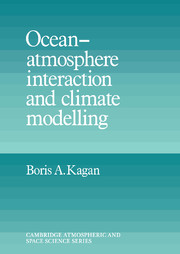Book contents
Preface
Published online by Cambridge University Press: 15 January 2010
Summary
In 1963 when the principal concepts of the study of ocean–atmosphere interaction had only been outlined, a group of leading American geophysicists (see Benton et al., 1963) stated: ‘We are beginning to realize dimly, although our information on this score is far from complete, that the atmosphere and the oceans which together constitute the fluid portions of the Earth actually function as one huge mechanical and thermodynamical system.’ And further: ‘A physical understanding of the processes of air–sea interaction should be one of the major objectives of geophysics during the coming decade.’ Thirty years have now passed and one of the least developed branches of geophysics has been transformed into an independent discipline with the aim of integrating the varied information on the ocean and atmosphere into a unified and balanced ‘picture of the world’, in order to provide an explanation as to the natural variability of mutually adjusted fields of climatic characteristics, to detect those common and distinctive features in hydrothermodynamics of both media (ocean and atmosphere) that are important for understanding the evolution of the climate, and to create a climatic theory, on which basis to forecast potential consequences of natural and anthropogenic forcings.
This progress has been achieved as a result of the realization of large experimental programmes on the one hand, and of the introduction of physical models on the other. Both these approaches are mutually complementary: the theoretical approach assumes the utilization of experimental data to test the models; the experimental approach assumes the introduction of conceptual ideas to be confirmed by modelling results.
- Type
- Chapter
- Information
- Ocean Atmosphere Interaction and Climate Modeling , pp. xi - xivPublisher: Cambridge University PressPrint publication year: 1995



